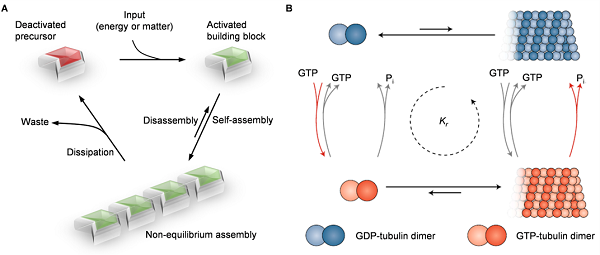- Newsroom
- Research Progress
- Academic Events
- Join Us
DNA-Based Dissipative Assembly toward Nanoarchitectonics
2022-06-21
Dissipative assembly resides in a non-equilibrium state with high energy. In such systems, continuous consumption of fuels is required to maintain the thermodynamically unfavored state. The constant input is converted by at least one chemical reaction to activate the precursor to assemble, and a deactivation process is accompanied, which dissipates the energy in the assembled system and reverts the system to the original state (Figure A). Importantly, the deactivation course must proceed at a relatively low rate compared to the activation process to ensure the formation of the transient intermediate. Such a dynamic process highly resembles some fundamental biological processes. For example, in eukaryotic cells tubulin dimers can be bound and activated by guanosine triphosphate (GTP) to self-assemble into microtubules and eventually lead to the formation of the cytoskeleton (Figure B). On the other hand, GTP can be hydrolyzed into guanosine diphosphate (GDP), and the hydrolysis rate is tremendously enhanced in the aggregated state, which lead to the collapse of microtubules because the GDP-bound tubulin dimers lose the ability to assemble into tubular structures. Therefore, GTP as a fuel must be provided continuously to maintain the integrity of microtubules that are in a non-equilibrium state.
In the last decade, especially during the last five years, an increasing number of work on DNA-based dissipative assemblies have emerged. However, the corresponding review summarizing the advances in this developing field is still missing. Therefore, with this review, we are trying to summarize the recent contributions in this emerging field which are categorized based on the fuel type: chemical, DNA/RNA, and light. Moreover, the factors that limit the development in the field are outlined, followed by the proposal of possible solutions.
 Abstract
Abstract
Link: https://onlinelibrary.wiley.com/doi/abs/10.1002/adfm.202201196
In the last decade, especially during the last five years, an increasing number of work on DNA-based dissipative assemblies have emerged. However, the corresponding review summarizing the advances in this developing field is still missing. Therefore, with this review, we are trying to summarize the recent contributions in this emerging field which are categorized based on the fuel type: chemical, DNA/RNA, and light. Moreover, the factors that limit the development in the field are outlined, followed by the proposal of possible solutions.

Deoxyribonucleic acid (DNA) represents an important class of molecular building blocks for the assembly of supramolecular functional systems primarily due to its molecular recognition capability and sequence programmability. Eventually, DNA-based nanostructures are assembled in a way that their states remain at the thermodynamic minimum of the energy. However, active life-like functions and their interactive adaption require the integration of energy away from thermodynamic equilibrium. The construction of DNA-based artificial systems was often inspired by the naturally occurring dissipative assembly processes, which leads to the consumption of energy to maintain the thermodynamically non-equilibrium state. In this review, the recent progress of the fabrications and properties of DNA-based dissipative assembly systems toward nanoarchitectonics is summarized. It focuses on the principle of dissipative assembly and shows some pioneering examples of DNA-based dissipative assembly systems. The latest corresponding perspectives are also proposed.
Link: https://onlinelibrary.wiley.com/doi/abs/10.1002/adfm.202201196